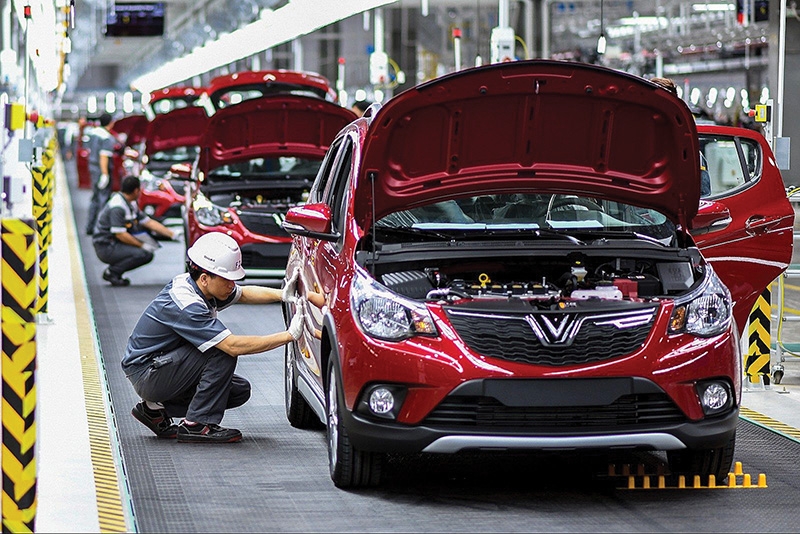Supporting industries leading automakers towards success
 |
| Vu Tan Cong, deputy general director of Vietnam Automobile Industry and Trade Consulting Co., Ltd |
In the Strategy on Vietnamese Industrial Development to 2025, with a vision to 2035, approved by the prime minister in 2014, the production of materials for the automobile industry is a priority for development.
The materials industry is the foundation for all of goods manufacturing. It creates many new jobs, adds value to goods, and reduces reliance on imports. It also creates many advantages in the implementation of free trade agreements, attracting foreign investment, and making it possible for Vietnam’s enterprises to participate in global supply chains.
Furthermore, it ensures the nation’s sovereignty and security, and enhances the nation’s brand worldwide.
Therefore, it is important for Vietnam to develop its materials industry, which is currently weak and does not meet the requirements of the nation’s industrialisation and development.
At present, Vietnam exploits many metals like copper, zinc, aluminium, iron ore, and silver. Due to lack of development of the materials industry, most of these exploited raw materials are exported at very low prices.
Thereby, it is advisable for Vietnam to develop the following materials on the basis of available natural resources.
 |
| Supporting industries are so vital that localisation rates can be improved and production costs can be lowered, Photo Le Toan |
Aluminium
Vietnam is the second-largest country in aluminium bauxite resources, with reserves of as much as 11 billion metric tonnes (MT). This resource is more than enough for both the domestic and export market. Currently, aluminium bauxite is mainly exploited by Vinacomin. Aluminium dioxide Al2O3 (98.5 per cent aluminium), exports at free on board prices of as much as $700 per MT.
In the automobile industry, aluminium alloys are widely used in many different parts and components like gasoline engine pistons, cylinder blocks and heads, generator housings, water pump housings, and wheels. However, most of these aluminium alloys are imported.
Steel and iron
Vietnam has iron ore reserves of up to 1.3 billion MT. Its steel production items are mainly construction steels, and not manufacturing steels. In addition, Vietnam exports a large quantity of iron ore to China and other countries at very low prices.
In the automobile industry, steel and iron alloys are used for manufacturing of many different parts and components like crankshafts, camshafts, valves, chassis frames, passenger car bodies, iron alloy cylinder liners, and diesel engine cylinder blocks and heads.
Plastics
In the revolution of automobile light weightings, plastic materials are widely used for many automobile parts and components like bumpers and dashboards. Plastic materials can be produced by using side products from oil refinery plants like Nghi Son and Dung Quat’s oil refinery bases.
At present, plastic materials for Vietnam automobile and motorbike part production are imported from China, Taiwan, South Korea, and India.
Rubber
Vietnam is abundant in natural rubbers that are raw materials for the production of many automobile parts and components. Currently, Vietnam is producing automobile tyres for both passenger cars and commercial vehicles.
However, the domestic rubber production industry needs further development to produce high-class tyres for passenger cars and high-class rubbers for other parts of automobiles such as windshield wipers, and engine and gearbox oil seals.
Glass
Vietnam has been producing glass for automobiles and commercial vehicles like trucks and buses. However, the country needs more investment for production of windshields for both commercial vehicles and passenger cars. There are 45 official members of the Vietnam Glass Association, which is capable of further development to become a member of the world’s supply chains
Other materials
Vietnam can further develop on the productions of other materials such as tungsten, copper, zinc, lead, titanium, nickel, chrome, and rare-earth metals. These materials are also important in production of many kinds of alloys.
Materials development
Even today, Vietnam’s automobile industry is still undeveloped and characterised by low localisation ratios, high production costs, and low levels of technology. Localisation ratios are 10-12 per cent and 45-50 per cent for passenger cars and commercial vehicles, respectively.
On average, production costs of passenger cars in Vietnam are about 10-12 per cent higher than those produced in ASEAN countries. In addition, Vietnamese automobile manufacturing technology is very limited, at the assembling level only.
This causes low added value for Vietnam’s locally-produced vehicles, causing lower competitiveness as compared with the same vehicles produced in ASEAN member states like Thailand, Indonesia, and Malaysia.
There are many reasons for this, but lack of a strong materials industry is among the top reasons.
Consequently, the industry is faced with very high pressure created by ASEAN-made imported passenger cars, which enjoy zero import tax rates.
Three local automobile big giants – THACO, TC Motors, and VinFast – are trying their best to implement their localisation program. However, the lack of locally-produced materials is still a big obstacle for them to overcome. If the Vietnamese government does not soon promulgate support and incentive policies to protect the local automobile production and policies on material industry development, the industry will be on the edge of collapse.
Many experts and authorities forecast that electric vehicles (EVs) will get increasingly popular around the world and in line with this tendency, the Vietnam automobile industry is advised to concentrate on EV manufacturing. In order to meet the market demands, the industry here will have to increase EV mileage per charge, while at the same time drop their prices.
These targets can be achieved when the vehicles become lighter, EV batteries are of higher accumulation, and they are designed in such ways that ensure minimum vehicle air and road resistance.
In order to achieve the above targets, again it is important to develop a materials industry for EV manufacturing.
Scientifically, lighter vehicles will consume less energy. A lighter model can be achieved by using lighter vehicle body and component materials like aluminium alloys, ultra-high-strength steels, and plastics and other light-high-strength materials, as well as optimisations in vehicle component design and layout.
Development solutions
Material production enterprises are ranked as third-level suppliers in the supporting industry sector. There have been so far many supporting and incentive policies to develop supporting industries.
These include the Law on Investment, Decree No.111/2015/ND-CP on the development of the supporting industries, Circular No.01/2016/TT-NHNN by the State Bank of Vietnam guiding loan development policies for supporting industries, Decision No.68/QD-TTG on approval of a supporting industry development programme for 2016-2025, and more besides.
However, these policies are not yet attractive enough to develop the materials industry. In order to develop, both businesses and the government are advised to try their best to work together.
As for business enterprises operating in the sector, we need to see more investment, higher enterprise management skills, more international relations and integration, deeper human resource enhancement, and stronger business-to-business connections.
For the government, a strategy on materials industry development should be considered and promulgated. This and related circulars and decisions must be clear, easy to implement, feasible, and attractive enough in order to boost the materials industry.
What the stars mean:
★ Poor ★ ★ Promising ★★★ Good ★★★★ Very good ★★★★★ Exceptional
Related Contents
Latest News
More News
- Kolon signs $48 million airbag supply deal with Autoliv (December 15, 2025 | 18:14)
- National Assembly approves Vinh–Thanh Thuy expressway project (December 15, 2025 | 18:02)
- Quang Tri green-lights $1.59 billion LNG-fired power project (December 15, 2025 | 17:59)
- Stress laid on high-quality FDI inflows (December 15, 2025 | 11:00)
- Can Tho utilises its growth advantages (December 15, 2025 | 09:09)
- Ca Mau unlocking potential to shape a more sustainable future (December 15, 2025 | 09:02)
- Major projects to be inaugurated nationwide (December 15, 2025 | 08:00)
- MoF workshop highlights mounting concerns over ODA on-lending costs (December 12, 2025 | 16:05)
- National Assembly approves pilot mechanisms to accelerate major projects in Hanoi (December 12, 2025 | 11:29)
- Legislation gives government flexibility for loan guarantees (December 11, 2025 | 18:04)

 Tag:
Tag:






















 Mobile Version
Mobile Version